Index
Unlike Corsair’s H50, ECO A.L.C. comes with a preinstalled fan which draws air through radiator fins and pushes it outside the case. Corsair on the other hand, recommends a setup where the fan will blow inside the case drawing cool air from the outside, which is perhaps a wiser option if you aim for better CPU cooling, but it can cause higher temperatures within the case. For comparison purposes however, in few tests we mounted Corsair’s H50 cooling so that it performs identically to the ECO A.L.C. i.e. push the air outward.
Radiator and fan size, as well as pump bases, are pretty much the same on ECO A.L.C. and Corsair H50, so testing should go pretty close. CoolIT’s radiator is a few millimeters wider and taller (picture, right), with 13 columns each with 94-95 aluminum fins. In comparison, Corsair’s H50 radiator features 12 columns each with 95-97 fins (we apologize if we missed a couple, feel free to zoom in and prove us wrong).

For our testing, we used Intel’s Core i7 965 XE CPU, both reference clocked and overclocked. This CPU has a 130W TDP and is a great candidate for our test. In the first part of our testing, we subjected our candidates to more extreme torture with power saving options in BIOS turned off, which resulted in a few °C more. In the second part of our testing we turned on Vdrop and EIST.
Idle temperatures were measured after half an hour of idle operation whereas our more demanding tests were performed with a little help of Prime95 blend test. We used Everest Ultimate Edition v5.50 to read CPU temperatures, as well as EVGA’s ECP V2 external control panel that comes with EVGA 4xSLI Classified motherboard.
We performed all tests three times, not only by restarting the rig but rather by taking the pump off, cleaning it and reapplying thermal paste. Ultimately we had to do it this way because of temperature differences during different measurement sessions. This could’ve been caused by thickness or thermal paste or just temperature changes in the room, so we ended up using average values taken from three repeated tests. Both systems (ECO A.L.C. and H50) performed similarly.
Test 1.
The setup:
EVGA 4xSLI Classified
Core i7 965 XE (3.2 GHz / 1.164 Volts)
Core i7 965 XE (3.6 GHz / 1.270 Volts)
Core i7 965 XE (4.0 GHz / 1.352 Volts)
Memory 6GB Corsair Dominator 12800 7-7-7-24
Graphics Card Point of View GTX 470
WD VelociRaptor 300G 10,000RPM
XFX 850W Black Edition PSU
Case: Cooler Master Test Bench (Open Case)
Fan Controler: Kaze Master Ace 5.25"
Gelid’s GX Extreme thermal paste.
Operating System: Win7 64-bit
Room temperature was at about 20°-21°C.
We performed the first test aiming to see how Corsair H50 handles
overclocking, so we didn’t turn on power saving options. We used EVGA 4x
SLI Classified motherboard, which unfortunately wouldn’t fit in out
Corsair Obsidian 800D case, so we performed this part of testing on
CoolerMaster’s open Test-Bench case. We’ll soon show temperatures
measured in Obsidian 800D case where we used EVGA 3x SLI motherboard.
For our air-cooling counterparts we used Cooler Master’s V8 cooler,
which packs eight heatpipes and one fan. It’s well worth noting that
this cooler is extremely quiet at lower RPM and will do some serious
cooling if you push it with the RPM-speed regulator. It’s currently
priced at below €42 here, so it’s currently a pretty nice deal.
In the following two tests, Corsair's fan followed CoolIT's method, i.e. drawing air through the radiator and blow it out of the case. The fan rans at maximum RPM.
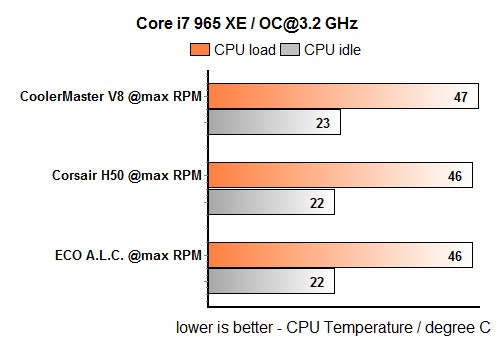
Without overclocking the CPU, performance difference between the ECO and
H50 was pretty much nonexistent, regardless of whether it’s idle
testing or intensive CPU testing. Overclocking the Core i7 965 Extreme
CPU (130W TDP) from 3.2GHz to 3.6GHz led to the first performance lead,
only 1°C, just enough for Corsair to come out on top.
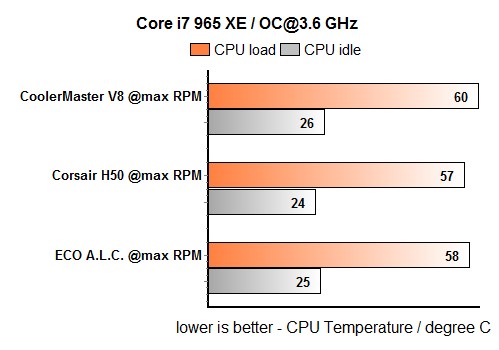
ECO A.L.C. showed that it packs enough juice to perform almost
identically to Corsair H50 during extreme overclocking.
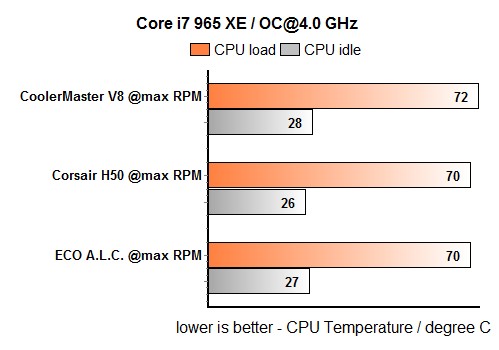
After our testing with CoolIT’s preinstalled fan, we decided to replace the provided fan with Scythe’s S-Flex SFF21G which is capable of airflow at 75.9CFM at 1900RPM. The new fan improved the performance by lowering the temperature by about 2°C during operation, but it ran much louder than CoolIT’s solution.

Test 2.
The setup:
EVGA 4xSLI Classified
Core i7 965 XE (3.2 GHz / 1.164 Volts, Intel EIST and Vdrop enabled)
Core i7 965 XE (3.6 GHz / 1.270 Volts, Intel EIST and Vdrop enabled)
Core i7 965 XE (4.0 GHz / 1.352 Volts, Intel EIST and Vdrop enabled)
Memory 6GB Corsair Dominator 12800 7-7-7-24
Graphics Card Point of View GTX 470
WD VelociRaptor 300G 10,000RPM
XFX 850W Black Edition PSU
Case: Cooler Master Test Bench (Open Case)
Fan Controler: Kaze Master Ace 5.25"
Gelid’s GX Extreme thermal paste.
Operating System: Win7 64-bit
Room temperature was at about 20°-21°C.
In this phase of testing we turned on Vdrop and EIST in our motherboard’s BIOS. This resulted in drastically lower temperatures compared to the previous tests – as much as 11°C lower. We mounted Corsair’s fan to mimic ECO A.L.C., i.e. push the air outwards.
Instead of Cooler Master’s V8 we used our freshly arrived Prolimatech Armageddon, which is a large 144 x 50 x 160.3mm cooler intended for 14cm fans. Prolimatech Armageddon is priced at 59.90 without the fan, but we quickly strapped it with Cooler Master’s A14025-10CB-3BN-F1 14cm fan. You can find out more on Prolimatech Armageddon on Caseking site here.
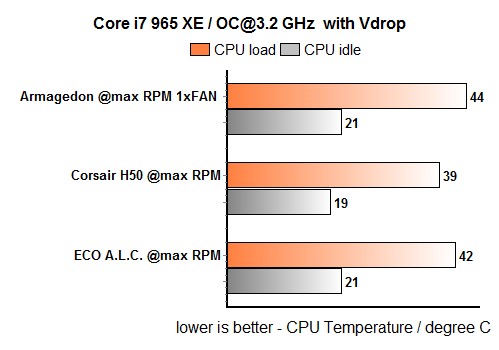
As you can see, Corsair H50 fares pretty well in this test, but it might be due to the fact that the testing was performed on an open test-bench case. In order to be sure that the “old” H50 indeed can beat the recently announced CoolIT ECO A.L.C. system, we did our tests in a closed case as well.
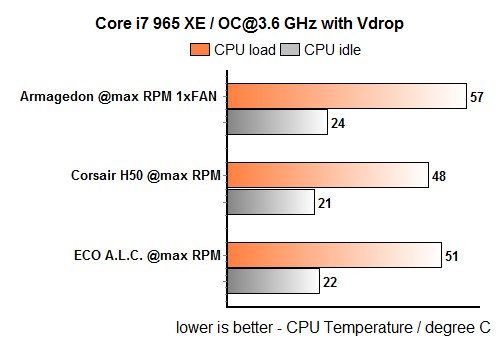
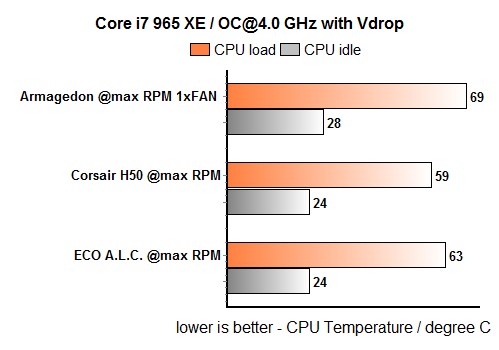
Test 3.
The third test shows temperatures we measured with our two cooling solutions within Obsidian’s 800D case. We tried both fan positions (blowing inward and outward) and even swapped the fans, which ran at maximum speed throughout our tests.
The setup:
EVGA 4xSLI Classified
Core i7 965 XE (3.6 GHz / 1.270 Volts, Intel EIST and Vdrop enabled)
Memory 6GB Corsair Dominator 12800 7-7-7-24
Sapphire HD 5830 (Modern Warfare 2)
WD VelociRaptor 300G 10,000RPM
XFX 850W Black Edition PSU
Obsidian 800D case
Fan Controler: Kaze Master Pro 5.25"
Gelid’s GX Extreme thermal paste.
Operating System: Win7 64-bit
Room temperature was at about 20°-21°C.
As you can see, the results are pretty evened out. We first show results with fans blowing air out of the case (ECO A.L.C.’s default) and then the results with fans blowing inwards.
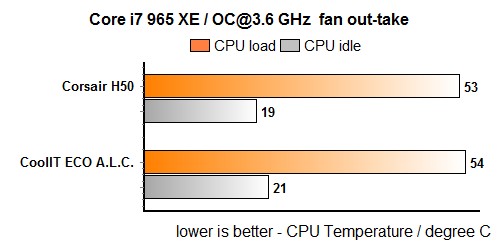
The following table shows that CPU cooling is better if the fan blows through the radiator and into the case, but it does raise overall temperature within the case.
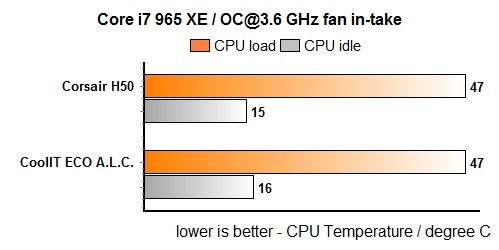
We measured temperatures by using Scythe’s Kaze Master Pro with 6 thermal sensors scattered around the case. One of the sensors was placed on the upper part of the case’s rear panel and it reports higher temperatures when the fan blows inwards, meaning that overall temperature within the case has risen. This thermal sensor recorded about 21°C when the fan blew outwards and about 28°C when the fan blew inward.
Obsidian 800D comes by default comes with no fans on the upper panel. Here you see it strapped with two Scythe S-FLEX SFF21G fans.
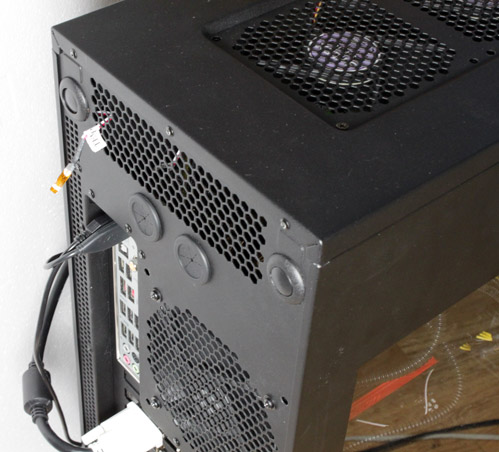
The following picture shows temperatures we measured on our second measuring position. We recorded about 27°C (fan blowing outward) and 33°C (fan blowing inward). The fourth and sixth thermal sensors showed no change in temperatures. Obsidian 800D’s bottom-panel fans push air upwards, and the fans on the top panel expel it out of the case.
We measured the same temperatures with Corsair’s H50 and ECO A.L.C.
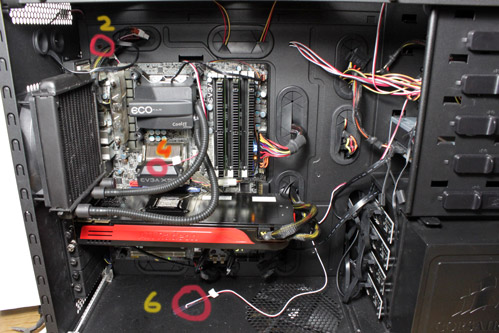
Now we move on to more interesting tests which show that Corsair’s H50 runs better with CoolIT ECO A.L.C.’s fan, and it’s worth noting that ECO A.L.C.’s performance drops with Corsair H50’s fan. We performed these tests with fans blowing out of the case, which we deem better overall.
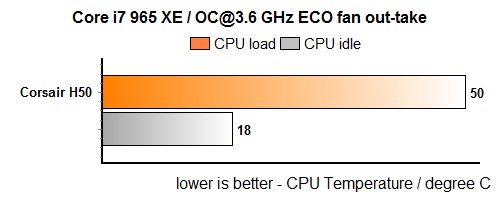
By using ECO’s fan, Corsair H50 performed up to 3°C cooler than with its own fan.
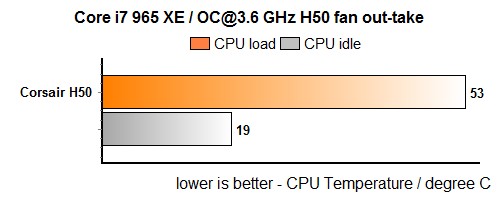
The following two tables show that ECO A.L.C. wasn’t very lucky with H50’s fan and temperatures rose by about 4°C. It appears that Corsair’s fan spins at 1650 RPM in our tests, although it should run at about 1700 RPM. ECO A.L.C.’s fan ran at about 1800 RPM.
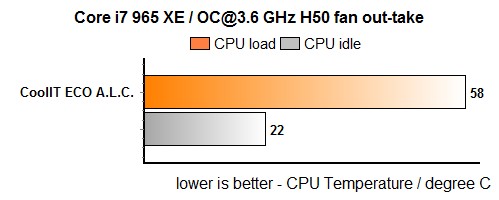

Copper base plate:






Noise
ECO A.L.C. fan is very quiet in idle and although it can well be heard
during the test, it’s in no way too loud. The results you see in the
tables above have been measured at maximum RPM in idle and during
testing. Maximum fan speed is 1800RPM and it runs silent at about
1050RPM. Of course, silence is golden so we advise you to use PWM and
Smart Fan feature with your ECO A.L.C. Performance is good with CoolIT’s
preinstalled fan so you won’t need to change it. The pump is also quiet
during operation and will be pretty much inaudible.
